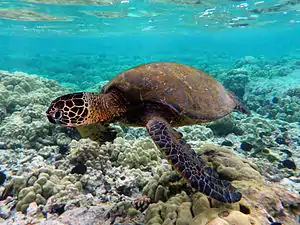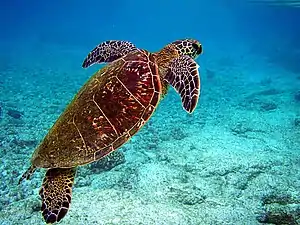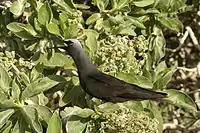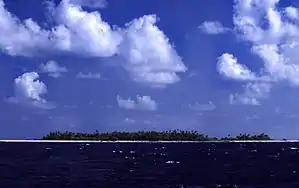Funafuti Conservation Area
The Funafuti Conservation Area is a marine conservation area covering 33 square kilometers (12.74 square miles) of reef, lagoon and motu (islets) on the western side of Funafuti atoll in Tuvalu. The marine environment of the conservation area includes reef, lagoon, channel and ocean; and are home to many species of fish, corals, algae and invertebrates. The islets are nesting sites for the green sea turtle (Chelonia mydas) and Fualopa hosts a breeding colony of black noddy (Anous minutes).
| Kogatapu (protected area) | |
|---|---|
| Geography | |
| Location | Western side Funafuti atoll, south of Tepuka islet (highlighted above) |
| Archipelago | Funafuti |
| Total islands | 6 |
| Major islands | Tepuka Vili Vili, (also called Tepuka Savilivili); Fualopa; Fuafatu; Vasafua; Fuagea (also called as Fuakea) and Tefala. |
| Area | 33 km2 (13 sq mi) |
| Highest elevation | 3 m (10 ft) |
| Administration | |
Tuvalu | |
The decision to create a protected area (Kogatapu) was made in 1999; the purpose of the Funafuti Conservation Area is the conservation of the marine and land based biodiversity (plants, animals and ecosystems) within the protected area. The boundaries of the Funafuti Conservation Area encompass about 20 percent of the total coral reef area of Funafuti lagoon (Te Namo).[1]
History
The project to create the Kogatapu began under the administration of the Funafuti Falekaupule (the Funafuti local council)[1] and with the support of the Secretariat of the Pacific Regional Environment Programme (SPREP), the conservation area was funded under SPREP's South Pacific Biodiversity Conservation Programme (SPBCP).[2][3] After surveys of the marine environment,[4] and consultation with the land owners and the Kaupule o Funafuti, (the elders and decision makers of Funafuti), the Government of Tuvalu created the Kogatapu in the Kaupule o Funafuti Conservation Area Order made under Section 3 of the Conservation Area Act, which order took effect on 1 December 1999.[5]
Land and marine environment


The Funafuti Conservation Area is sometimes called the 'Kogatapu Conservation Area' or 'Funafuti Marine Conservation Area'. Six islets (motu, in the Tuvaluan language) are included in the Funafuti Conservation Area: Tepuka Vili Vili, (also called Tepuka Savilivili); Fualopa; Fuafatu; Vasafua; Fuagea (also called Fuakea) and Tefala.[6] Vasafua was severely damaged by Cyclone Pam. The coconut palms were washed away, leaving the islet as a sand bar.[7][8]
The Tuvalu National Biodiversity Strategy and Action Plan of 2009 describes the marine environment as comprising six major ecosystem types: oceanic, outer reef, lagoonal, back reef, lagoon floor, and patch reefs, plus natural channels between the ocean and lagoon. It says these ecosystems produce sediment that is required for island building and maintenance and support communities of corals, other invertebrates, algae, plankton, fish and marine mammals and reptiles.[9]
Coconut crabs (Birgus latro) live on the islets, which are also nesting sites for the green sea turtle (Chelonia mydas)[3] ("Fonu" in tuvaluan).[10] The IUCN Red List identifies only the green turtle as being found in Tuvalu. The green turtle is recognised as critically endangered. The Secretariat of the Pacific Regional Environment Programme (SPREP) lists two additional turtle species as being found in Tuvalu: hawksbill sea turtle (Eretmochelys Imbricate) and leatherback sea turtle (Dermochelys coriacea), with both species being recognised as critically endangered.[11]
The marine environment of the Kogatapu includes reef, lagoon, channel and ocean; and are home to many species of fish, corals, algae and invertebrates.[12][2][3] Surveys prior to 1999 identified 76 species of indicator fish, 141 species of food fish and 149 mobile invertebrates such as crabs and sea cucumbers.[13] A 2007 survey established that fish populations had increased as a result of the Funafuti Conservation Area. Large-sized individual fishes of the highly prized target food species, such as grouper and snapper were observed; the presence of so many large fish of desirable target food species indicates that there is very low fishing pressure in the Funafuti Conservation Area,[14] although enforcement by conservation rangers of the no-fishing rules is necessary to preserve the fish stock.[9]
Surveys were carried out in May 2010 of the reef habitats of Nanumea, Nukulaelae and Funafuti (including the Funafuti Conservation Area) and a total of 317 fish species were recorded during this Tuvalu Marine Life study. The surveys identified 66 species that had not previously been recorded in Tuvalu, which brings the total number of identified species to 607.[15][16]
Low densities of reef sharks were recorded in the Tuvalu Marine Life study. Four species of reef shark have been identified: grey reef shark (Carcharhinus amblyrhynchos), blacktip reef shark (Carcharhinus melanopterus), whitetip reef shark (Triaenodon obesus) and lemon shark (Negaprion brevirostris), which are all listed on the IUCN Red List of threatened species, as ‘near threatened’ species.[16]
The Tuvalu Marine Life study also recorded low densities of two species of rays: manta ray (Manta birostris) and spotted eagle ray (Aetobatus narinari), which are both listed on the IUCN Red List of threatened species, as ‘near threatened’ species.[16]
Oceanic species
The range of tiger shark (Galeocerdo cuvier), oceanic whitetip shark (Carcharhinus longimanus) and mako shark (Isurus) includes the ocean around Tuvalu. The mako is known as rokea in the Tuvaluan language.
Skipjack tuna, yellowfin tuna, bigeye tuna and giant trevally are the larger pelagic fish that are found in the ocean around Tuvalu.
The pantropical spotted dolphin (Stenella attenuata) and other cetacea, including sperm whale (Physeter macrocephalus ) and orca or killer whale (Orcinus orca), are also found in the ocean around Tuvalu.[11][17][18]
Bird life of Tuvalu


Surveys have established a total of 35 bird species as confirmed in Tuvalu,[19] including:
- 9 species of terns (Sternidae)
- 7 species of sandpipers (Scolopacidae)
- 4 species of shearwaters and petrels (Procellariidae)
- 3 species of boobies (Sulidae)
- 2 species of tropicbirds (Phaethontidae)
- Great frigatebird (Fregata minor)
- Lesser frigatebird (Fregata ariel)
Pacific imperial pigeon (Ducula pacifica) live in the broadleaf forest. Migratory birds are found in Tuvalu, such as long-tailed cuckoo (Eudynamys taitensis) or areva (Tuvaluan).[20] The birds found in Tuvalu include 17 breeding species, such as:
- eight species of migratory shorebirds, including the globally threatened species, bristle-thighed curlew (Numenius tahitiensis);[19] and
- nine species of seabirds, including black noddy (Anous minutes) or taketake (Tuvaluan).[19]
Native broadleaf forest

The native broadleaf forest is limited to 4.1% of the vegetation types on the islands of Tuvalu.[22] The islets of the Kogatapu have 40% of the remaining native broadleaf forest on Funafuti atoll. The Tuvalu forest gecko (Lepidodactylus tepukapili) is endemic to Tuvalu,[23][24] and has been located in the Kogatapu on Fuagea (also called Fuakea) and on Tepuka.[23][25]
While coconut palms are common in Tuvalu, they are usually cultivated rather than naturally seeding and growing. Tuvaluan traditional histories are that the first settlers of the islands planted coconut palms as they were not found on the islands. The native broadleaf forest of Funafuti includes the following species, that were described by Charles Hedley in 1896,[26] which includes the Tuvaluan name (some of which may follow Samoan plant names):
- Fala or screw pine, (Pandanus)
- Puka or pouka, (Hernandia peltata)
- Futu, (Barringtonia asiatica)
- Fetau, (Calophyllum inophyllum)
- Ferra, (Ficus aspem), native fig
- Fau or fo fafini, or woman's fibre tree (Hibiscus tiliaceus)
- Lakoumonong, (Wedelia strigulosa)
- Lou, (Cardamine sarmentosa)
- Meili, (Polypodium), fern
- bird's-nest fern, Asplenium nidus
- Milo or miro, (Thespesia populnea)
- Ngashu or naupaka, (Scaevola taccada)
- Ngia or ingia, (Pemphis acidula), bush
- Nonou or nonu, (Morinda citrifolia)
- Sageta, (Dioclea violacea), vine
- Pukavai, (Pisonia grandis)
- Talla talla gemoa, (Psilotum triquetrum), fern
- Tausunu or tausoun, (Heliotropium foertherianum)
- Tonga or tongo, (Rhizophora mucronata), found around swamps
- Tulla tulla, (Triumfetta procumbens), whose prostrate stems trailed for several feet over the ground
- Valla valla, (Premna taitensis)
Donald Gilbert Kennedy, the resident district officer in the administration of the Gilbert and Ellice Islands Colony from 1932 to 1938, identified other trees found in the broadleaf forest:[27]
- Pua, (Guettarda speciosa)
- Kanava, (Cordia subcordata)
Access to the Kogatapu
The protected lagoon, coral reefs and bommies of the Kogatapu provide for snorkeling and scuba diving. Access to the Funafuti Conservation Area is by boat; the Conservation Area is 15 kilometres (9.3 mi) across the lagoon (called Te Namo) from the main island of Fongafale.
References
- "Funafuti Strategic Plan 2011-2015" (PDF). Funafuti Falekaupule. February 2011. Archived from the original (PDF) on 4 March 2016. Retrieved 26 April 2015.
- Hugh Govan & Sandrine Job; et al. (June 2007). "Funafuti Atoll Coral Reef Restoration Project – baseline report" (PDF). Coral Reefs in the Pacific (CRISP), Noumea. Retrieved 26 October 2011.
- "Tuvalu Funafuti Conservation Area". Ministry of Communication, Transport and Tourism – Government of Tuvalu. Archived from the original on 9 May 2013. Retrieved 28 October 2011.
- Kaly, U.L., T. M. Alefaio, C. M. Ludescher, K. Talakatoa and S. Alefaio, (1999) Second marine survey of Funafuti conservation area, Tuvalu, Funafuti Town Council.
- "Kaupule o Funafuti Conservation Area Order" (PDF). Government of Tuvalu. 2008. Retrieved 28 October 2011.
- Admiralty Nautical Chart 2983 Tuvalu - Funafuti atoll. United Kingdom Hydrographic Office (UKHO).
- Wilson, David (4 July 2015). "Vasafua Islet vanishes". Tuvalu-odyssey.net. Retrieved 22 July 2015.
- Endou, Shuuichi (28 March 2015). "バサフア島、消失・・・(Vasafua Islet vanishes)". Tuvalu Overview (Japanese). Retrieved 22 July 2015.
- Dr A J Tilling & Ms E Fihaki (17 November 2009). Tuvalu National Biodiversity Strategy and Action Plan (PDF). Fourth National Report to the Convention on Biological Diversity. p. 7.
- Hedley, Charles (1896). General account of the Atoll of Funafuti (PDF). Australian Museum Memoir 3(2): 1–72. pp. 63–68.
- "Pacific Islands Regional Species Programme 2008-2012" (PDF). Secretariat of the Pacific Regional Environment Programme (SPREP). 2007. Retrieved 9 October 2013.
- Randy Thaman, Feagaiga Penivao, Faoliu Teakau, Semese Alefaio, Lamese Saamu, Moe Saitala, Mataio Tekinene and Mile Fonua (2017). "Report on the 2016 Funafuti Community-Based Ridge-To-Reef (R2R)" (PDF). Rapid Biodiversity Assessment of the Conservation Status of Biodiversity and Ecosystem Services (BES) In Tuvalu. Retrieved 25 May 2019.CS1 maint: multiple names: authors list (link)
- "Call - A newsletter for Conservation Areas in the Pacific, Issue no. 3" (PDF). Secretariat of the Pacific Regional Environment Programme (SPREP). July–September 1999. Retrieved 28 October 2011.
- Berdach, James T. (June 2007). "Case Study: The Funafuti Conservation Area, Funafuti Atoll, Tuvalu - Drawing Lessons for Future Marine Conservation Planning and Management" (PDF). Government of Tuvalu / Asian Development Bank. Archived from the original (PDF) on 25 December 2004. Retrieved 26 October 2011.
- Sandrine Job, Dr. Daniela Ceccarelli (December 2011). "Tuvalu Marine Life Synthesis Report" (PDF). an Alofa Tuvalu project with the Tuvalu Fisheries Department. Retrieved 3 December 2013.
- Sandrine Job, Dr. Daniela Ceccarelli (December 2012). "Tuvalu Marine Life Scientific Report" (PDF). an Alofa Tuvalu project with the Tuvalu Fisheries Department. Retrieved 3 December 2013.
- Miller, Cara (14 February 2006). Current State of Knowledge of Cetacean Threats, Diversity and Habitats in the Pacific Islands Region. WDCS Australasia Inc. p. 98.
- Murase, H & Temoai, I & Kirata, Taratau & Finkaso, S & Yasunaga, Genta & Pastene, L.A. (2014). "A note on cetaceans off Kiribati and Tuvalu from a research cruise in October 2010". Journal of Cetacean Research and Management. 13: 153–158.CS1 maint: multiple names: authors list (link)
- Parr, John W.K. (January 2008). "Important bird areas in Tuvalu". BirdLife International. Retrieved 26 October 2011.
- Hedley, Charles (1896). General account of the Atoll of Funafuti (PDF). Australian Museum Memoir 3(2): 1–72. p. 46.
- Funafuti Marine Conservation Area, Tuvalu: report of the bird survey (August 31 - September 11, 1998). South Pacific Regional Environment Programme. 1998. p. 14. OCLC 64390275.
- Randy Thaman, Feagaiga Penivao, Faoliu Teakau, Semese Alefaio, Lamese Saamu, Moe Saitala, Mataio Tekinene and Mile Fonua (2017). "Report on the 2016 Funafuti Community-Based Ridge-To-Reef (R2R)" (PDF). Rapid Biodiversity Assessment of the Conservation Status of Biodiversity and Ecosystem Services (BES) In Tuvalu. Retrieved 25 May 2019.CS1 maint: multiple names: authors list (link)
- George R. Zug, Dick Watling, Tataua Alefaio, Semese Alefaio, and Claudia Ludescher (2003). "A new gecko (Reptilia: Squaniata: Genus Lepidodactylus) from Tuvalu, South-central Pacific". Proceedings of the Biological Society of Washington. 116 (1): 38–46. S2CID 38959270.CS1 maint: multiple names: authors list (link)
- Lepidodactylus tepukapili at the Reptarium.cz Reptile Database
- "Lepidodactylus tepukapili Zug, Watling, Alefaio, Alefaio & Ludescher" (PDF). polynesian diversity. 12 February 2012. Archived from the original (PDF) on 4 March 2016. Retrieved 25 May 2019.
- Hedley, Charles (1896). General account of the Atoll of Funafuti (PDF). Australian Museum Memoir 3(2): 1–72. pp. 30–40.
- Kennedy, Donald (1931). The Ellice Islands Canoe Journal of the Polynesian Society Memoir no. 9. Journal of the Polynesian Society. pp. 71–100.
Further reading
- Lepage, Denis. "Checklist of birds of Tuvalu". Bird Checklists of the World. Avibase. Retrieved 30 April 2007.
- Clements, James F. (2000). Birds of the World: a Checklist. Cornell University Press. p. 880. ISBN 0-934797-16-1.
- Child, P. (1960). "Birds of the Gilbert and Ellice Islands Colony Atoll". Research Bulletin. 74.
- Hedley, Charles (1896). "General account of the Atoll of Funafuti" (PDF). Australian Museum Memoir. 3 (2): 1–72. doi:10.3853/j.0067-1967.3.1896.487.
- Lobel, P.S. (1978). "Gilbertese and Ellice Islander names for fishes and other organisms" (PDF). Micronesica. 14 (2).
- Watling, Dick, A Guide to the Birds of Fiji and Western Polynesia: Including American Samoa, Niue, Samoa, Tokelau, Tonga, Tuvalu and Wallis and Futuna, Environmental Consultants (Fiji) Ltd; 2nd edition (2003)
- Thaman, R.R. (May 1992). "Batiri Kei Baravi: The Ethnobotany of Pacific Island Coastal Plants" (PDF). Atoll Research Bulletin, No. 361, National Museum Of Natural History, Smithsonian Institution. Retrieved 8 February 2014.
- Randy Thaman, Feagaiga Penivao, Faoliu Teakau, Semese Alefaio, Lamese Saamu, Moe Saitala, Mataio Tekinene and Mile Fonua (2017). "Report on the 2016 Funafuti Community-Based Ridge-To-Reef (R2R)" (PDF). Rapid Biodiversity Assessment of the Conservation Status of Biodiversity and Ecosystem Services (BES) In Tuvalu. Retrieved 25 May 2019.CS1 maint: multiple names: authors list (link)

